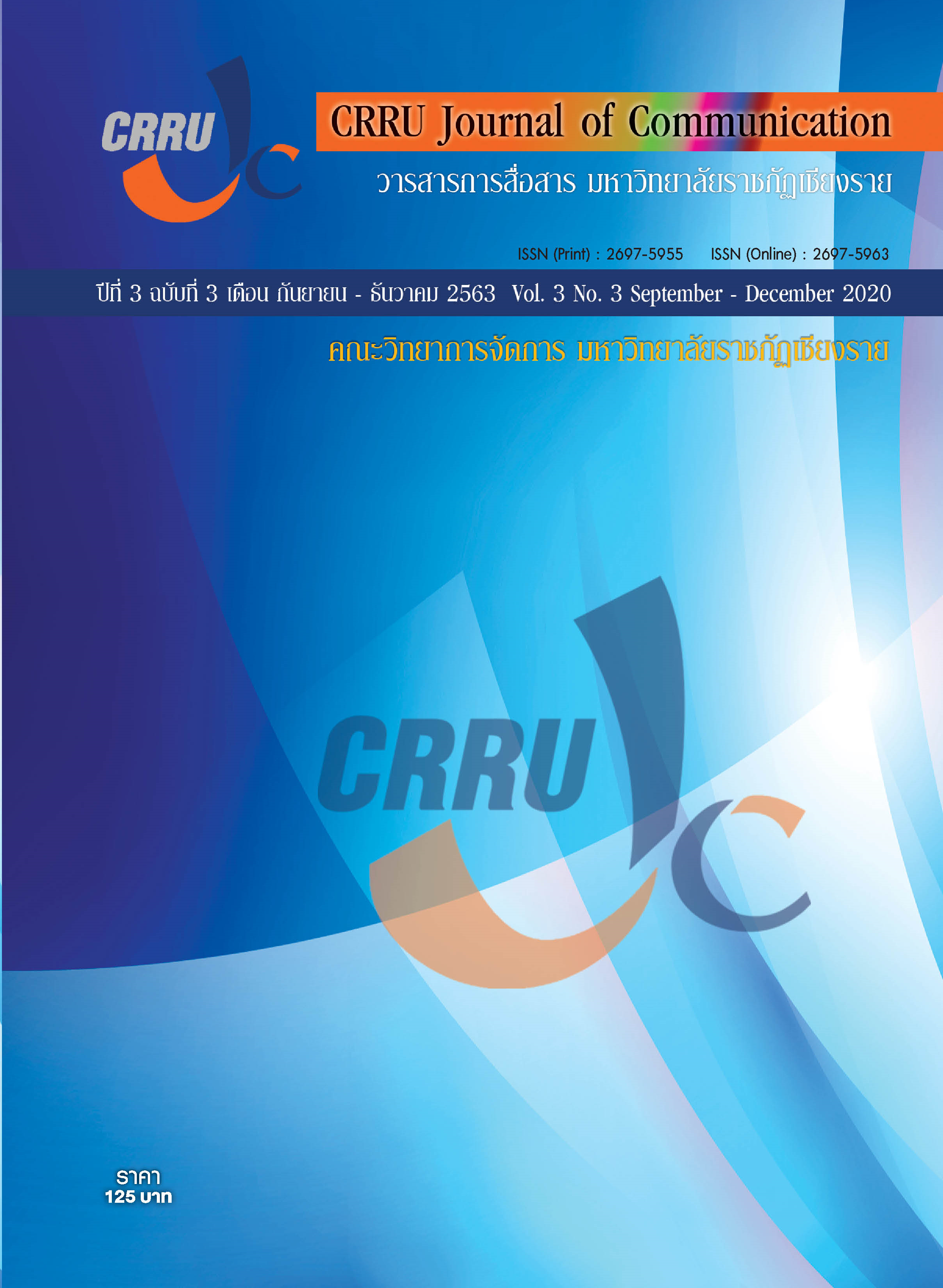Communication Strategic through Social Network in preparing for the aging society
Main Article Content
Abstract
The objectives of this qualitative study were threefold: to examine public sectors’ policies and concepts of health communication with older persons via social media, determine issues of health communication with older personal via social media, and to explore the older persons’ media exposure to health news via social media. According to the examination of public sectors’ policies, the government was found to support and develop its older persons through the integration of 4 related principles: 1. prevention, restoration, and development of older persons’ health system, 2. a retirement saving campaign launched to encourage healthy older persons to be employed and work freelance, 3. provision of public transport and settings for convenient and safe access by older persons, and 4. provision of education to help older persons develop new media and technology literacy so that they can be exposed to social media news coverage with awareness and without being vulnerable to digital crimes. The investigation of social network indicated that to promote older persons’ media literacy, mass media should provide reliable news and increase the quantity of verified news content as much as possible. This is because the more trusted news, the less fake ones. Importantly, public sectors have to determine each news issue in compliance. This can help mass media become so interested that the information can be disseminated to the public. Based on the findings obtained from the older persons themselves, it was suggested that public sectors should set up a core establishment, so called One Stop Service Oldie, which unites care and development for older persons in particular. This can promote extensive operation allowing them to easily access information on health, environment, income, and new technology. Moreover, this One Stop Service Oldie expected to look after older persons more directly than individual organizations.
Article Details
References
กรมอนามัย สำนักส่งเสริมสุขภาพ. (2554). คู่มือการดูแลผู้สูงอายุ. พิมพ์ครั้งที่ 16. กรุงเทพฯ: โรงพิมพ์องค์การสงเคราะห์ทหารผ่านศึก.
กาญจนา แก้วเทพ และขนิษฐา นิลผึ้ง. (2556). สื่อสารอาหารและสุขภาพ. กรุงเทพฯ:โครงการเมธีวิจัยอาวุโสฝ่ายวิชาการ สำนักงานกองทุนสนับสนุนการวิจัย.
กิรณา สมวาทสรรค์. (2559). การศึกษาพฤติกรรมการสื่อสารกับการส่งต่อข้อมูลผ่านแอพพลิเคชั่นไลน์ของผู้สูงอายุ. (วิทยานิพนธ์ปริญญามหาบัณฑิตX, สถาบันบัณฑิตพัฒนาบริหารศาสตร์.
กนิษฐา เทพสุด. (2561). พฤติกรรมการใช้โซเชียลมีเดียที่เกียวกับสุขภาพกับการรู้เท่าทันสื่อของผู้สูงอายุที่เป็นเบาหวาน ในกรุงเทพมหานคร. วิทยานิพนธ์ปริญญาดุษฎีบัณฑิต, มหาวิทยาลัยธุรกิจบัณฑิตย์.
นวภัทร์ ธรรมชอบ. (2562). ความต้องการการเปิดรับและความพึงพอใจในการใช้สื่อของผู้สูงอายุยุคสังคม 4.0 ในเขต กรุงเทพมหานคร. วิทยานิพนธ์ปริญญาดุษฎีบัณฑิต, มหาวิทยาลัยธุรกิจบัณฑิตย์.
น้ำทิพย์ วิภาวิน. (2558). เครือข่ายสังคมในสังคมเครือข่าย. วารสารวิจัยสมาคมห้องสมุด. 8(2), 191-127.
นิด้าโพล. (2556). ผู้สูงอายุไทยกับการใช้เวลาว่าง. สืบค้นจาก http://nidapoll.nida.ac.th/index.php?op=polls-detail&id=300. เมื่อวันที่ 18 มีนาคม 2562.
ปรเมธี วิมลศิริ. (2559). สถานะสุขภาพของคนไทย (รายงานวิจัย). สถาบันวิจัยคณะกรรมการพัฒนาการเศรษฐกิจและสังคมแห่งชาติ.
ปราโมทย์ ปราสาทกุล. (2556). สถานการณ์ผู้สูงอายุ แนวโน้ม และผลกระทบจากการเข้าสู่ประชาคมอาเซียน. กรุงเทพฯ: ศูนย์เทคโนโลยีสารสนเทศและการสื่อสาร สำนักงานปลัดกระทรวงการพัฒนาสังคมและความมั่นคงของมนุษย์.
ปิญาภรณ์ พงศ์ศาสตร์.(2560). พฤติกรรมและบทบาทสื่อสารของผู้สูงอายุในชุมชนหมู่บ้านอีสานตอนกลาง. วิทยานิพนธ์ปริญญาดุษฎีบัณฑิต, มหาวิทยาลัยธุรกิจบัณฑิตย์.
แผนพัฒนาสุขภาพแห่งชาติฉบับที่ 12 พศ. 2560-2564. สืบค้นจาก https://www.anamai.moph.go.th/download/2560/. เมื่อวันที่ 1 มีนาคม 2562.
พนา ทองมีอาคม และเพ็ญพักตร์ เตียวสมบูรณ์กิจ. (2551). การสื่อสารสุขภาพ : ประโยชน์และความจำเป็นของการศึกษาด้านนิเทศศาสตร์และการบริหารด้านสุขภาพ. วารสารวิชาการคณะนิเทศศาสตร์มหาวิทยาลัยรังสิต. 12(2), 9-18.
ภาณุ อดกลั้น. (2556). ทฤษฎีการสูงอายุ. อุดรธานี : วิทยาลัยพยาบาลราชชนนี.
วรเวศม์ สุวรรณระดา (2556).การศึกษาพฤติกรรมการสื่อสารกับการส่งต่อข้อมูลของผู้สูงอายุ.วารสารนิเทศศาสตร์จุฬาลงกรณ์มหาวิทยาลัย. 6(2), 14-25.
รัตนา จักกะพาก และระวี สัจจโสภณ. (2554). สื่อเพื่อผู้สูงอายุในประเทศไทย : สภาพการณ์ปัจจุบัน ความคาดหวัง แนวโน้มในอนาคตและการกำหนดยุทธศาสตร์เชิงรุก (รายงานวิจัย). คณะนิเทศศาสตร์ จุฬาลงกรณ์มหาวิทยาลัย.
ศรีไพร โชติจิรวัฒนา, พรสุข ตันตระรุ่งโรจน์ และสิริพันธุ์ สุวรรณมรรคา. (2562). การประเมินความต้องการจำเป็นการใช้เทคโนโลยีสารสนเทศและการสื่อสารเพื่อสนับสนุนการรู้สุขภาพในศูนย์การเรียนรู้ สำหรับผู้สูงอายุในกรุงเทพมหานครและปริมณฑล. วารสารบรรณศาสตร์ มศว. 12 (2), 60-74.
สุชาดา พงศ์กิตติวิบูลย์. (2563). บทเรียนจากการประเมินโครงการเพื่อความคุ้มค่าและการพัฒนาศักยภาพโครงการด้านการ
เฝ้าระวังและรู้เท่าทันสื่อ. วารสารวิทยาการการจัดการ มหาวิทยาลัยราชภัฎเชียงราย. 15(1), 114-132.
อัมพร เบญจพลพิทักษ์ และคณะ. (2555). คู่มือความสุข 5 มิติสำหรับผู้สูงอายุ. กรุงเทพฯ: บริษัท บียอนด์พับลิสซิ่ง จำกัด
Division of the Department of Economic and Social Affairs of the United Nations Secretariat (2015). Asean Poupulation. Retrieved from http://variety1.thaiza.com/. Date March 5, 2019.
The Standard. (2020). Thailand Population. Retriever from www.worldometers.info/world-population/thailand-population/. Date November 25, 2020.
Nattida Rattanawut. (2012). What is Social Media. Retriever from http://www.marketingoops.com/media-ads/social-media/what-is-social-media. November 22, 2020.
ลัดดา ดำริการเลิศ. สัมภาษณ์. 11 มีนาคม 2562.
สกานต์ บุนนาค. สัมภาษณ์. 21 มีนาคม 2562
พีรพล อนุตรโสติร์. สัมภาษณ์. 2 เมษายน 2562
บุญลือ สุวรรณ. สัมภาษณ์. 22 เมษายน 2562
สุจินดา นำแสงวาณิช. สัมภาษณ์. 24 เมษายน 2562


